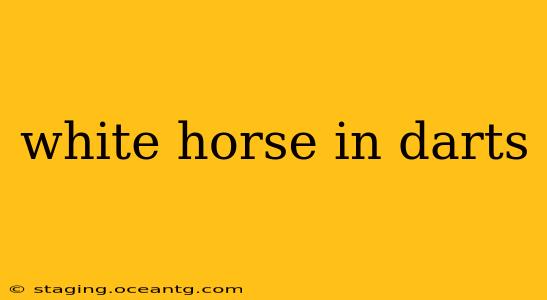The "White Horse" in darts isn't a specific, officially recognized term like a double or treble. Instead, it refers to a particular, often unspoken, aspect of the game's strategy and psychology. It's a metaphorical representation of the pressure and challenge a player faces when needing a specific score to win a leg or match. This guide will delve into the nuances of "the White Horse," exploring its meaning, impact on gameplay, and how top players navigate this critical moment.
What Exactly is "The White Horse" in Darts?
"The White Horse" describes the daunting feeling of needing a specific score to finish a leg, often a high score requiring multiple shots. Imagine this: you're in a crucial match, nearing victory, needing 121 points to win. This isn't just about hitting the numbers; the pressure mounts exponentially, potentially leading to missed shots and even a loss. This pressure, this looming finish, is the White Horse. It's the mental obstacle players must overcome.
Why is it Called "The White Horse"?
The origin of the term isn't definitively documented, but it likely evokes the imagery of a powerful, imposing creature – something difficult to conquer. The "white" might symbolize the purity of the finish needed, the clear path to victory that can be quickly obscured by pressure. It suggests a formidable challenge that demands skill, precision, and mental fortitude.
How Does the White Horse Affect Darts Players?
The White Horse significantly impacts a player's performance. The heightened pressure can lead to:
- Increased nervousness: This can manifest as shaky hands, altered aim, and rushed shots.
- Loss of focus: Players may overthink their shots or forget their strategy.
- Mental blocks: The fear of failure can become paralyzing, hindering their ability to execute even simple throws.
- Increased risk-taking: Desperate for a win, players might opt for risky shots with a lower probability of success.
How Do Professional Darts Players Overcome the White Horse?
Elite darts players develop strategies and techniques to manage the pressure of the White Horse:
- Mental training: This involves practicing visualization, mindfulness, and stress management techniques.
- Routine: A consistent pre-shot routine helps to calm nerves and focus the mind.
- Experience: Years of competition build resilience and the ability to perform under pressure.
- Strategic shot selection: Experienced players choose finishes that maximize their chances of success, even if it means taking a slightly longer route.
- Confidence: Believing in one's abilities is crucial to overcoming mental hurdles.
What are some common strategies for hitting a high checkout?
Many different strategies exist depending on the score needed, but here are a few examples:
- Practicing various finishes: Regular practice of different checkouts improves the player's ability to react effectively under pressure.
- Identifying your best doubles: Knowing which doubles you consistently hit is vital for a successful finish.
- Breaking the checkout down into smaller parts: Instead of focusing solely on the entire checkout number, breaking it down into manageable chunks can reduce pressure.
Can beginners avoid "the White Horse"?
While beginners might not experience the same intensity of pressure as professionals, the concept of needing a specific score to win is still relevant. Practicing pressure situations, even in casual games, helps build resilience and prepare players for more high-stakes scenarios. Focusing on consistent practice and developing good technique are fundamental in minimizing the negative effects of this pressure.
Conclusion: Mastering the White Horse
The White Horse in darts is a testament to the mental and physical demands of the sport. It's a challenge that separates good players from great ones. By understanding its impact and developing strategies to overcome the pressure, players of all levels can improve their game and achieve greater success. The key is consistent practice, mental preparation, and a belief in one's abilities.
